
Researching tradition, fashion and identity in Macedonian aprons in the Illawarra
Meredith Walker, Heritage Consultant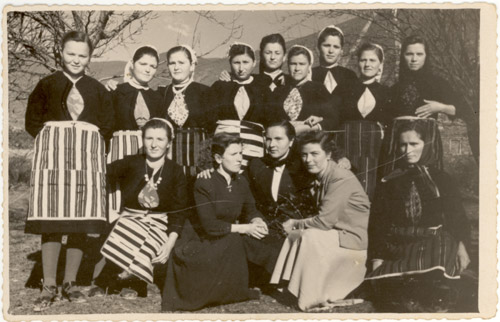
Women from Zurce, near Dolenci, wearing traditional costume in 1954. The three women in the centre front are from the city of Bitola.
In 2006, while reading KOMPAS, the Macedonian community magazine, I noticed a 1936 photograph of two young women wearing almost identical aprons. ‘It’s the apron worn by young women in the village of Velusina’ the manager of the Macedonian Welfare Association (MWA), Mendo Trajcevski, told me. I quizzed everyone at the MWA that day: ‘Yes, each village, every locality had its own apron style; some of them have bright pink stripes’, I was told. As a founding member of the National Apron Front (an underground organisation devoted to neglected heritage and aprons of all descriptions), I switched to ‘high apron-alert’. Had these aprons been brought to Australia, to the Illawarra?
Mendo and I discussed options for a project and decided to seek support for research and an exhibition. Like the online National Quilt Register, we adopted as a core premise for the project the principle that all aprons brought to Australia can contribute to the history of traditional aprons and are equally significant. Everyday aprons used for going to the village, working around the home, or in the fields, would be recorded – as well as the aprons worn with traditional formal dress at a wedding or saint’s day. A long-term goal was to understand the traditions and fashions of apron design in the villages in the Bitola and Ohrid regions, the source of most of the Macedonian-born people in the Illawarra.
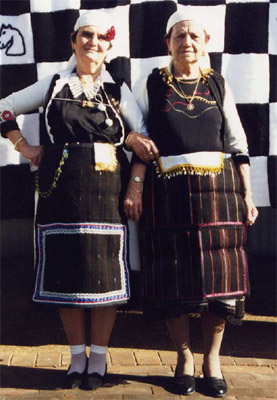
Gjurga Petrovska and Milica Dimoska dressed in traditional costume Port Kembla, 2005. Photo by Mendo Trajcevski.
In September 2007, John Petersen, Manager of the Powerhouse Museum’s Migration Heritage Centre, offered the MWA funds for a small website exhibition about Macedonian aprons. It was the incentive needed to encourage people to come forward with their aprons. Day care groups from Cringila, Port Kembla and Shellharbour, and visitors to the MWA office, took part in the project. Bilingual workers at the MWA interviewed the owners, and sometimes (at the owner’s request) modelled the costumes to be photographed. Owners were asked about the history of each apron: who made it, where it was made, the source of the design, and how the apron came to Australia. Family photographs were scanned, providing tangible evidence of the evolution of tradition and fashion.
At the conclusion of the interviews, John Petersen showed the research and photographs to the director of the Powerhouse Museum, Dawn Casey. She was impressed by the aprons and their stories and made the decision to mount a temporary exhibition at the Museum to complement the web exhibition.
Forty-three aprons from 16 villages have been recorded. All the aprons were made in the 20th century, with most woven by the owners themselves, their mothers, mothers-in-law or grandmothers. The aprons woven in the 1920s to early 1970s were traditional village dress, made for everyday wear and special occasions. As fashions changed in the 1970s and ’80s the aprons were often made as keepsakes, or for dancing. Traditional aprons are the most common objects that Macedonian-born people retain from their migration journey, having left most of their belongings behind. The aprons symbolise the owner’s ties with family, tradition and identity in Macedonia.
Gjurga Petrovska (pictured left) brought two aprons and three dresses to Australia, when she and her children joined her husband in 1971. Gjurga could not bear to leave the traditional clothes behind; she had made them by hand and loved the work. Since the age of eight, Gjurga was taught by her mother to sew, knit, and eventually to spin and operate the loom. Each year she made one new dress, usually in winter, when there wasn’t much farm work. She also made blankets, bedspreads and rugs, using wool cleaned, spun and dyed from the family’s sheep. Her work was greatly admired in the village of Logovardi, near Bitola.
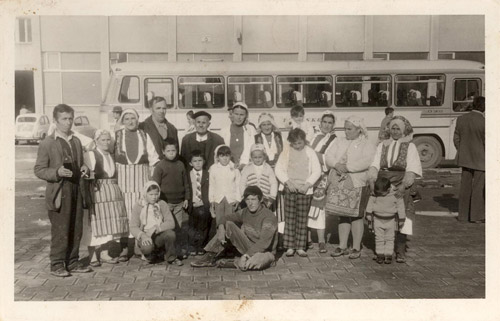
Gulapka Krstanoska (sixth from left), her family and well wishers, leaving Ohrid for Australia on 10 December 1974. Photo courtesy Gulapka Krstanoska.
Gulapka Krstanoska came to Australia by air in 1974, bringing only one apron with her, which had been made by her mother in the village of Meseista, near Ohrid in 1957. Her mother had also made Gulapka’s wedding apron and other special occasion and everyday aprons. This was the tradition in her family - the mothers made the aprons for the daughters. Her grandmother had done the same for Gulapka’s mother.
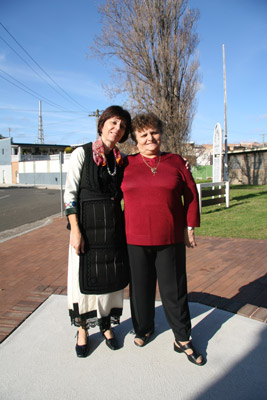
Jana Stojanovski with MWA volunteer Mira Nicolovski wearing Jana's traditional costume at the Port Kembla Community Centre, 2008. Photo by Mendo Trajcevski.
Jana Stojanovski’s mother wove this special occasion apron (pictured above). The trim, ties and other embroidery for the traditional costume were made in the Logovardi village style by a tailor, as a present from her father in 1957. Jana wore the costume when part of a dancing group.
Our interviews have revealed that while apron owners knew the designs popular in their village and nearby, few know the traditions and fashions in other areas. This research provides new information from the era when village customs were being overtaken by city fashions and many people’s lives and villages were changed by migration.
Mendo Trajcevski estimates that there may be another 100 or more Macedonian aprons in the Illawarra, and numerous photos of apron wearing. Further research will build the picture of apron styles and fashions and document the story of traditional aprons in the mid 20th century and how they came to the Illawarra. It is hoped that the project will extend to other Australian cities, so that aprons from every town and village in the Bitola and Ohrid regions might be revealed and recorded.
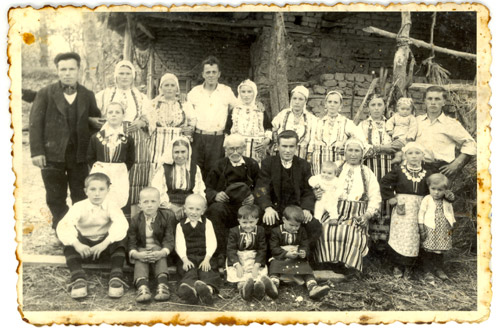
This photograph of Spasija Aleksoska’s extended family was taken in Trebenista, near Ohrid, during Easter celebrations in 1959.
Perhaps a museum curator from the region could visit, or a loom acquired to remake remembered ‘lost’ aprons, or design new aprons for the Illawarra ‘villages’? As a result of this project we hope that the cultural significance of these aprons will be recognised and that keeping and treasuring Macedonian aprons will become an Australian tradition.